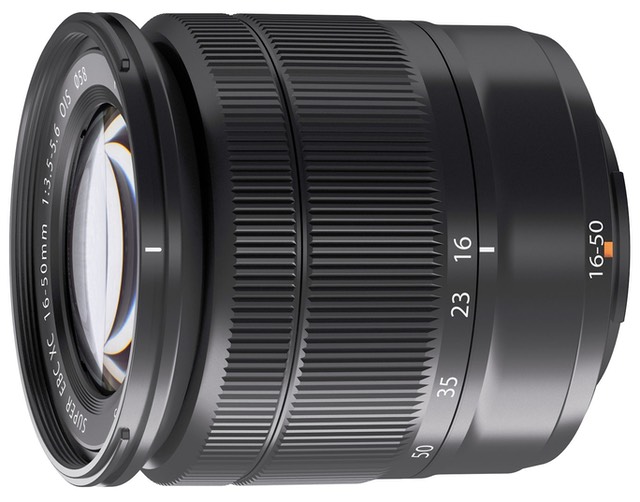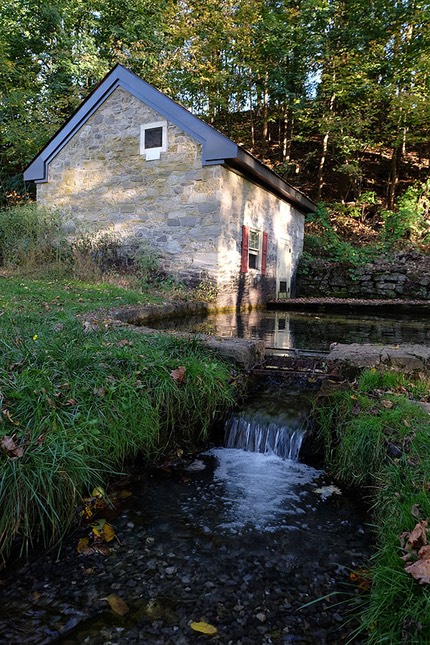
What is it?
The 16-50mm f/3.5-5.6 XC OIS lens is the kit lens with some of the lower-priced X mirrorless cameras from Fujifilm. As such, it's a fairly simple lens, with no buttons, DOF scales, aperture rings: just a focus ring and a zoom ring, basically. The focus ring is a fly-by-wire ring, not mechanical coupled to the focusing system.
The lens does have Fujifilm's OIS system built in, which is controlled from the camera's menus.
While not a big or heavy lens ( tk ), the lens doesn't collapse like some kit lenses for mirrorless cameras. With the hood attached you're looking at something that extends 4" from the front of the camera at 16mm, and nearly 6" at 50mm. The 58mm filter ring does not rotate during zoom or focus.
The lens is built in China.
How's it Handle?
Not much to say as we only have the two rings and the bayonet lens hood (supplied) to explore. The hood reverses on the lens, which is a good touch not always implemented on a kit lens like this. The zoom ring on my sample is somewhat stiff, but smooth. The focus ring is fly-by-wire and very loose and smooth, but there's absolutely lag (delay) in response when you manually focus and you won't feel like you're in discrete control of the focus (i.e. you'll probably tend to overshoot small adjustments).
Build quality is good. The lens seems rugged enough, though when extended to 50mm I can force a bit of wobble in the extended plastic section of the lens, a common problem with low cost lenses.
How's it Perform?
Do you want it to have it's costume on or off? ;~)
Fujifilm performs a great deal of in-camera lens adjustments for JPEG images, and they've worked closely with most software vendors to automatically apply the same adjustments in raw converters, too (Adobe, Phase One, etc.). So let's deal with the things that get adjusted first.
Linear distortion: Perhaps 1% barrel distortion at 16mm after correction, with everything from about 24mm onward showing minimal distortion that can be ignored. But turn off the corrections and things are very different. At 16mm, the lens has about 7% barrel distortion, which is a lot and un-ignorable. This tapers to a bit over 2% at 24mm, then back to negligible by the time you're at 35mm. The problem with this much distortion correction is that it impacts the MTF numbers the lens can achieve. More on that in a bit.
Vignetting: Again, the corrections do a pretty good job of keeping everything pretty minimal. At no point do I even measure a half stop in corrected JPEGs and raw files. Of course, without the correction the story is again quite different. At 16mm wide open there's 1.5+ stops of vignetting. You really need to get to f/8 to get down to a reasonable amount of vignetting. This has some ramifications for noise in the corners of images, obviously. It's like you're underexposing the corners of your image and then bringing them significantly up with post processing. So I wouldn't call this a low light lens. At other focal lengths (24mm, 35mm, 50mm) the numbers were much more reasonable, with only wide open at 50mm showing a bit more than a stop of vignetting. Stopping down one stop brings vignetting mostly under control at every focal length except the widest.
Chromatic aberration: A bit higher than I would have expected with all the corrections going on. It's clearly present at wide angles, mostly ignorable at normal and telephoto focal lengths.
Sharpness: Surprisingly, the MTF numbers stay high even with the corrections. The center is excellent at 16mm through 35mm, really only dropping down to very good at 50mm. The corners were unexpectedly decent at 16mm, with not a lot of drop off in sharpness from the center. As you zoom in, however, the corner sharpness starts deviating more and more from the central sharpness. I'd call corner sharpness only fair at best case beyond 16mm. Another surprise is how little difference there is in this lens between wide open and the point where diffraction starts taking away some contrast. This is a lens you can use wide open to f/8 and get pretty much the same results from. And that's particularly true of JPEG shooting.
Overall, the performance is mostly what you expect from a kit lens: good, but not great.

Straight out of camera JPEG at 16mm. Note the lines are corrected, the corners brightened. Sharpness is good in the full image out to about two thirds the way to the corners, at which point it begins to degrade. But in a shot like this, corner sharpness isn't all that important.
Final Words
At 16mp, the 16-50mm almost shines in the center of the frame, but is weak at the edges (except for 16mm, though there are a lot of built-in software corrections being applied to prop up the widest angle). It's actually quite a suitable optic for an entry level camera and a consumer user, as with Fujifilm's adjustments in software there really isn't a glaring fault that shows through.
Of course, take away those adjustments and the lens is less interesting. Too much linear distortion and vignetting coupled with slightly soft corners make results look a little myopic when you examine totally uncorrected raws. This isn't any worse than other mirrorless makers, though: software corrections are the savior of a lot of the kit lenses currently available.
Still, it's a shame that the lens doesn't hold the corners well in sharpness. It would have been nice to have a really sharp convenience lens for the X cameras. The 18-55mm is bigger and heavier, which pretty much means that we resort to a few primes to get solid results on our X bodies without bulking up.
That said, the lens is a pretty good match as the kit lens for the X-A1 and X-M1. Those are cameras that a more consumer-oriented user is going to buy, and the 16-50mm suits that just customer mostly fine with the corrections that are applied to JPEGs automatically.
Support this site by purchasing from this advertiser:
